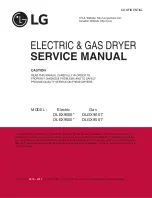
DO NOT
attempt to dry dripping wet articles.
DO NOT
use the tumble dryer if you suspect that it is
damaged in any way. Under no circumstances should you
attempt to repair the appliance yourself. Repairs carried out by
inexperienced persons may cause serious injury. Consult your
local appointed service engineer and insist on genuine spare
parts.
The final part of the tumble dryer cycle occurs without heat
(cool down cycle) to ensure that the items are left at a
temperature that ensures that the items will not be damaged
INSTALLATION
Position the tumble dryer so that the plug remains accessible after installation. Do not block the vent at the front or
base of the dryer, as this will impair the working of the machine. This appliance must not be installed behind a
lockable door, a sliding door or a door with hinges on the opposite side to that of the tumble dryer.
TUMBLE DRYER VENTING
Your tumble dryer will release warm, damp air in one of three ways.
1) EXTENDABLE REAR VENTING
- A long flexible vent hose is built into the dryer
and can be extended from the large opening at the rear of the machine
2) FIXED REAR VENTING -
Venting is through the large opening at the bottom of
the rear panel. A separate extendible vent hose can be attached if desired.
3) FRONT VENTING
- This is a special type of dryer which vents through a grille on the
plinth. The opening on the rear panel is blanked off during manufacturing.
Rear vented dryers can be used without a vent hose but not in a confined space. Rear vented machines must
have a vent hose if they are installed under a work surface. To minimise condensation it is preferable to vent
through a vent to outside. This may be through an open door or window. The best solution is to connect the vent
hose to a permanent connection through a wall or a single glazed window.
This is particularly recommended for small, cool rooms. A kit for this purpose is available as an accessory.
Front venting machines must be converted to extendible rear venting before a permanent connection can be
made to the outside.
When using a vent hose, remember the following points:
The vent hose must be at least 10cm (4 ins) in diameter.
No more than three right-angled bends should be allowed when positioning the vent hose.
Do not distort or constrict the vent hose as this will reduce the airflow.
The vent hose must not be shared with other appliances, for example, a cooker hood outlet.
FINAL INSTALLATION
THE CONTROLS
Push the filter into its operating position as shown in
the diagram. If you wish to change the side on which
your door opens, see the instructions on the back
page. Remove any dust by wiping the drum and door
with a damp cloth. Any initial smell of burning will
be caused by dust on the heater and will quickly
disappear.


























